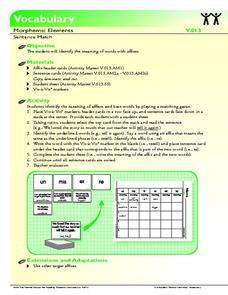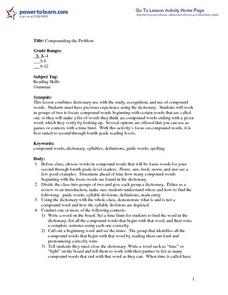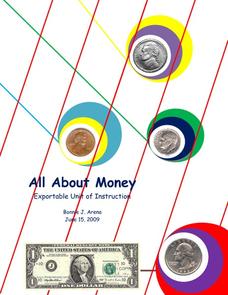Florida Center for Reading Research
Vocabulary: Morphemic Elements, Sentence Match
Ask your class to puzzle out the meaning of various affixes. Learners read sentences and develop a new word with an affix to replace the underlined words. They write down the words and help to categorize them by affix.
Houghton Mifflin Harcourt
Amazing Animals: Challenge Activities (Theme 4)
For kids who have already mastered the basic concepts in the Houghton Mifflin Harcourt thematic units on amazing animals, here's a packet of enrichment activities sure to provide food for fertile minds.
Literacy Connects
Activities to Build Phonological Awareness
Begin your reading program each day with a mini lesson on phonological awareness using these engaging activities listed in the resource. Young ones will enjoy word families, clapping and counting syllables, identifying single sounds and...
Macmillan Education
Alice's Adventures in Wonderland
Follow Alice as she travels through Wonderland with a set of lessons based on the first chapter of the book. Learners discuss key moments and ideas from chapter 1 before answering a series of comprehension questions about what they have...
SEN Teacher
Literacy Dice
Reinforce literacy skills using a six-sided die that focuses on phonics and story starters. Scholars roll, and show what they know about blends, plots, and more!
Curriculum Corner
New Year's Collection
As the new year approaches, it is time to reflect and set goals. This year, use a set of New Year's worksheets to set individual academic and personal goals, as well as classroom goals. Half of the packet could be completed before class...
Curated OER
Gerund as Subject
Working in groups, learners practice using gerunds as subjects by talking to one another. Then, independently, they write sentences using a subject, a verb, and a subject complement from a given list of each and in their own words. They...
Curated OER
Identifying Antonyms
After a class discussion that reviews the concept of antonyms, learners get into groups of four. Their first task is to come up with as many antonyms as they can. One person writes an antonym pair and passes the paper to the next...
Achieve3000
Discriminating Phonemes
Develop the fluency of beginning readers one sound at a time with this phonemic awareness lesson. Through a series of whole-class instruction, independent practice, and collaborative learning activities, children practice identifying the...
Harper Collins
If You Give...Series Teaching Guide
If you give teachers a few good ideas, they can really bring a story to life. Included in this resource are dozens of activities to use as your class reads books in the If You Give... series. From holding puppet shows and creating comic...
Curated OER
Compounding the Problem
Pupils sharpen their dictionary skills and their understanding of compound words in this plan. Tailor it to the grade level you teach by honing in on specific skills. For older learners, the plan suggests providing a word and having them...
Curated OER
Aches and Pains
Being able to distinguish between short and long vowel /a/ sounds is an important skill for young readers. They are introduced to the vowel-consonant-e pattern that changes short vowel sounds into long vowel sounds. They practice reading...
Curated OER
All About Money
Few topics engage young mathematicians as much as learning about money. Through a series of shared readings and hands-on activities, children explore the US currency system, learning how to count money and calculate change as they create...
Lerner Publishing
Meet the Dinosaurs
Take your class of youngsters on a prehistoric adventure with this four-lesson series on dinosaurs. Accompanying the Meet the Dinosaurs books by Don Lessem, these lessons engage children in writing their own dinosaur books, making...
Elementary CORE Academy
Food Foldable
There's nothing as satisfying as a crunchy carrot or a juicy apple! Teach your middle and high schoolers about healthy eating habits with a set of nutrition activities. After analyzing the model of the food pyramid, learners apply the...
Kate Stickley
Reading the World: Latitude and Longitude Lesson latitude and longitude, maps, coordinates on a map, prime meridian, reading maps, equator, globes
Find five activities all about longitude and latitude! Use oranges to show the equator and prime meridian, plot birthdays on a map using coordinates, and plan a dream vacation.
Education World
Pilgrim Projects
Finally! Here are some new and fresh ideas, across the curicullum, that can be used around the Thanksgiving holiday. The lesson is divided up into two sections: Beyond Turkey - Activities for Younger Students and, Beyond Turkey -...
Channel Islands Film
Lone Woman of San Nicolas Island: Lesson Plan 4
Imagine being stranded all alone on an island for 18 years. How would you survive? Class members are challenged to makes necessities out of natural materials that would likely be found on an island.
Wild BC
Maple Trees and Marmots
Kinesthetic activities simulate animal activity as the seasons progress in a lesson that introduces climate change to primary pupils. The kids role-play maple trees collecting what they need to survive, but as each year comes around, the...
PBS
Heart to Heart
Study heart health and math in one activity. After measuring their resting heart rates by finding the pulse in their wrists, learners build a stethoscope to listen to their heart rate, and note the differences between the two methods.
Other popular searches
- English Language Arts Games
- Word Games Language Arts
- Language Arts Games Clauses
- Language Arts Games 8
- Fun Language Arts Games
- Language Arts Games 8th
- Phonic Language Arts Games
- Language Arts Games Modals
- Games for Language Arts





















